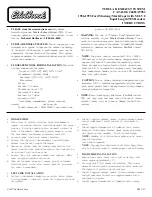
When driving down hills, reduce
your speed, and shift down to second
gear. Do not ‘‘ride’’ the brakes, and
remember, it will take longer to slow
down and stop when towing a trailer.
If you must stop when facing uphill,
use the foot brake or parking brake.
Do not try to hold the vehicle in
place by pressing on the accelerator,
as this can cause the automatic
transmission to overheat.
Crosswinds and air turbulence
caused by passing trucks can disrupt
your steering and cause the trailer to
sway. When being passed by a large
vehicle, keep a constant speed, and
steer straight ahead. Do not try to
make quick steering or braking
corrections.
Drive slower than normal in all
driving situations, and obey posted
speed limits for vehicles with trailers.
If you have an automatic
transmission, use the D position
when towing a trailer on level roads.
D3 is the proper shift lever position
to use when towing a trailer in hilly
terrain. (See ‘‘
’’ in the
next column for additional gear
information.)
Make turns more slowly and wider
than normal. The trailer tracks a
smaller arc than your vehicle, and it
can hit or run over something the
vehicle misses. Allow more time and
distance for braking. Do not brake or
turn suddenly as this could cause the
trailer to jackknife or turn over.
When climbing hills, closely watch
your temperature gauge. If it nears
the red (Hot) mark, turn the air
conditioning off, reduce speed and, if
necessary, pull to the side of the
road to let the engine cool.
If the automatic transmission shifts
frequently while going up a hill, shift
to D3.
CONTINUED
Towing a Trailer
Handling Crosswinds and Buf f eting
Making Turns and Braking
Towing Speeds and Gears
Driving on Hills
Driving on Hills
D
riv
ing
287
Summary of Contents for 2010 Accord Coupe
Page 6: ......
Page 126: ...120 ...
Page 266: ...260 ...
Page 346: ...340 ...
Page 396: ...390 ...
Page 407: ......
Page 408: ......
Page 409: ......
















































